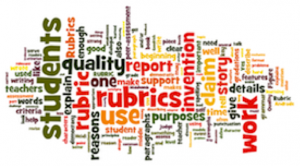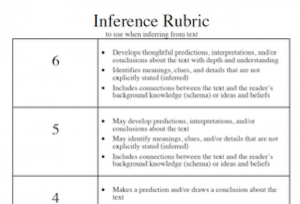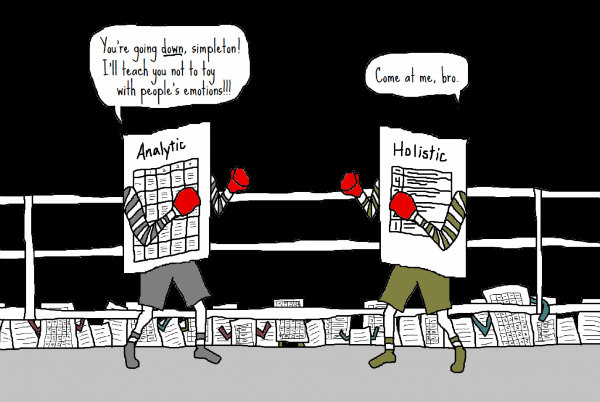All About Rubrics: A MiddleWeb Resource
“What is a rubric? A rubric is a coherent set of criteria for student work that describes levels of performance quality. Sounds simple enough, right?
“Unfortunately, rubrics are commonly misunderstood and misused. The good news is that when rubrics are created and used correctly, they are strong tools that support and enhance classroom instruction and student learning…
“Author Susan M. Brookhart identifies two essential components of effective rubrics: (1) criteria that relate to the learning (not the ‘tasks’) that students are being asked to demonstrate, and (2) clear descriptions of performance across a continuum of quality.” – From the description of How to Create and Use Rubrics for Formative Assessment and Grading (ASCD, 2013)
Why all those searches for rubrics?
Some of MiddleWeb’s busiest pages are those featuring information about rubrics. Why all the traffic? Rubrics have become part of routine lesson planning, of course. But done right, they can move beyond the “routine” and serve as excellent tools for formative assessment.
Rubrics can give teachers important information about the effectiveness of instruction and give students an understanding of how their efforts relate to levels of achievement. And they can strengthen learning when kids have a hand in creating them.
The abuse of rubrics over the past decade and more makes some squeamish, caught in this quotation from Todd Finley in an Edutopia article on crafting inspiring rubrics:
“A generation of essays has soaked in the antiseptic taste of writing rubrics’ viscous marinade. It’s time to throw them on the grill, wave our two-pronged spatulas and cheer at the sizzle and smoke.”
The resources we’ve amassed here attempt to avoid the antiseptic taste and emphasize rubrics that really make a difference.
For starters, you can visit our MiddleWeb rubrics articles (with sample rubrics) from earlier years. They include an excellent post from the late 1990s that features a thorough introduction to rubrics by assessment scholar and former Harvard Project Zero staffer Heidi Andrade.
We’ve also included links there to several teacher-created rubrics. One can be used to help determine students’ inference levels. Others address independent writing. (Several of these rubrics were created or adapted by literacy teacher/author Juli Kendall.)
Also at MiddleWeb, frequent contributor Sarah Tantillo often writes about rubrics in her posts. Her article 7 Simple Steps to Better Student Writing includes an Essay Writing Rubric that helps students assess their work.
Most recently (2024), these two MiddleWeb articles by teacher leader Stephanie Farley are being shared frequently in education social media: Creating Rubrics That Foster Student Growth and Single Point Rubrics Are Efficient and Impactful.
Beyond MiddleWeb
Get a brisk primer (with great examples) on three kinds of rubrics from Jennifer Gonzalez at Cult of Pedagogy. She shows samples and explains holistic, analytic and single-point rubrics, sharing the strengths and weaknesses of each. To see the single-point rubric in action, read her post How to Turn Rubric Scores into Grades from the eighth grade classroom.
For a detailed look at rubric varieties read What Are Rubrics and Why Are They Important?, the first chapter from How to Create and Use Rubrics for Formative Assessment and Grading by Susan M. Brookhart.
To access other recent resources, visit the extensive collection of rubrics links at Kathy Shrock’s blog launched in 2024. Her Assessment and Rubrics post includes a generous selection of rubrics related to the Common Core, general and subject-specific classes, multimedia and digital skills, and more.
Rubrics Past and Present
The pedagogical conversations about rubrics stretch all the way back to the 1970’s when the term “rubric” drifted over to education from medicine. But we’ll just tack back to around 1990 when Heidi Andrade was beginning her study of educational psychology.
In her decade-long work at Harvard and its Project Zero, Andrade helped define the effective use of rubrics as she investigated learning and assessment. Today, Andrade serves as an education associate dean at University at Albany, SUNY. Two of her journal articles, accessible online, are particularly helpful for middle grades educators.
Writing with doctoral student Zachary B. Warner in the New York State United Teachers Educator’s Voice, Andrade considers student self-assessment in Beyond “I Give Myself an A.” Using a language arts rubric and a math checklist, Andrade explains the learning that self-assessment can build. She and Warner conclude:
“The implications for classroom practice that emerge from this research seem relatively straightforward: Students ought to be actively engaged in critiquing sample pieces of work, in thinking together about the criteria by which their work will be evaluated, and in self-assessment of their works in progress.”
Andrade continues: “By involving students in the assessment process in these ways, teachers can blur the distinction between instruction and assessment. This can transform many activities in the classroom into a seamless flow of analyzing models, creating products, and continuously evaluating and improving products. These are habits or routines that can have a lifelong positive effect — well beyond the content of a particular curriculum.”
To see the challenges faced by middle school teachers in a months-long effort to improve student writing, also read Assessment-Driven Improvements in Middle School Students’ Writing, an AMLE article by Andrade and Knickerbacker Middle School educators Colleen Buff, Joe Terry, Marilyn Erano, and Shaun Paolino (accessed through ERIC).
A Rapid Review
For a quick review on shaping effective rubrics, read two articles by Andrew Miller, a National Faculty Member for ASCD and the Buck Institute for Education and a consultant. In the first post (published at ASCD Inservice), Miller provides 4 Tips to Get More Out of Rubrics. He explains why rubrics can most benefit students if they have (1) commonality in form among classes or grade levels (2) consistent uses, and (3) a focus on learning targets. He also notes that teachers need to differentiate rubrics from simple checklists. In his second article (at Edutopia), Tame the Beast: Tips for Designing and Using Rubrics, Miller notes the challenges of using rubrics and includes word choice and format suggestions.
A Thorough Exam
For a more detailed look at rubrics that work, visit the blog of the late Grant Wiggins, co-author of Understanding by Design and author of Educative Assessment and many articles. In Part 1 of Intelligent vs. thoughtless use of rubrics and models, he briefly sums up the problems of unhelpful rubrics (“invalid criteria, unclear descriptors, lack of parallelism across scores, etc.”) and notes that “the most basic error is the use of rubrics without models. Without models to validate and ground them, rubrics are too vague and nowhere near as helpful to students as they might be.”
In Part 2 of his rubrics discussion, Wiggins revisits a 20-year-old essay, updating it to consider validity, scoring holistically versus judging independent dimensions, comparable language versus descriptive language, quantitative versus qualitative differences, the challenge of encouraging creativity, and other issues — all treated in a conversational tone and with some lively comments at the end.
From Standards Based to Life Skills Rubrics
Writing for AMLE in What Have Rubrics Got To Do With It? DuPage College professor and consultant April Zawlocki explains how to develop standards-based rubrics to replace traditional rubrics and goes on to describe her development of life skills rubrics.
A Creativity Rubric?
Formerly a teacher and a professor, consultant Susan M. Brookhart considers assessing creativity as opposed to grading it in an article at Educational Leadership. Brookhart, whose book How to Create and Use Rubrics for Formative Assessment and Grading is reviewed at MiddleWeb here, notes that assessing creativity can help students understand and achieve it. She continues:
“I created this rubric with some trepidation — because where there’s a rubric, there will be someone who’s thinking of using it to grade. Generating a grade is not the intended purpose of the rubric for creativity. Rubrics help clarify criteria for success and show what the continuum of performance looks like, from low to high, from imitative to very creative. For that reason, rubrics are useful for sharing with students what they’re aiming for, where they are now, and what they should do next. I do not recommend grading creativity.”
Want to share your experiences with rubrics in the classroom? Please comment below.



































I would also like to point folks to The Literacy Cookbook, which offers some excellent writing rubrics (http://www.literacycookbook.com/page.php?id=87) and oral fluency rubrics (http://www.literacycookbook.com/page.php?id=30) to teachers who purchase a membership. These practical tools have been proven to work in the field! Cheers, ST